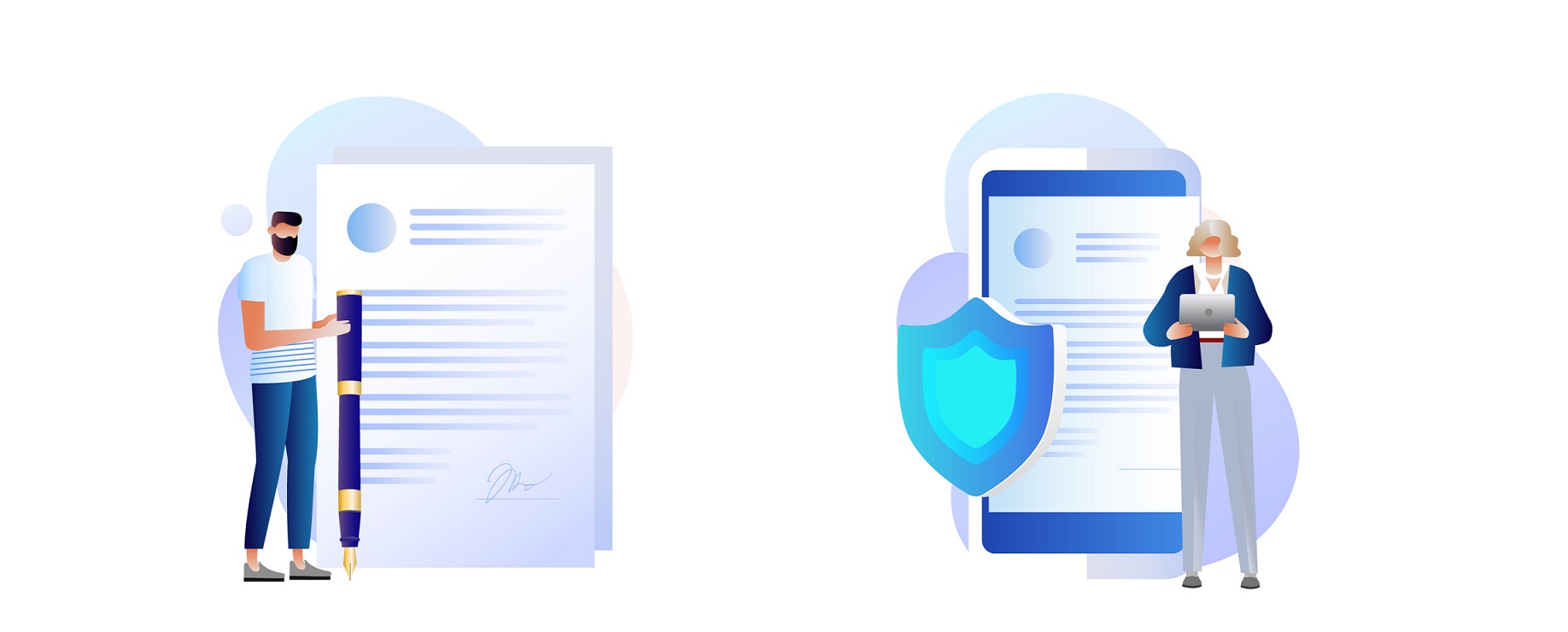
Delivering killer customer service is a top priority for all businesses, no matter the industry.
As we’ve recently discussed, one of the keys to delivering top-notch customer service is consistency.
(After all, if your customers know you’ll always be able to help them, they’ll have every reason to keep doing business with your brand, right?)
The thing is:
Your team won’t just develop this consistency as a matter of course.
And it’s not going to happen overnight.
(And it certainly won’t happen by accident.)
To consistently deliver high-quality customer service, your efforts need to be built on a solid foundation.
In short:
You need a customer service policy.
What is a Customer Service Policy?
A customer service policy is a set of guidelines and principles that a company follows in order to provide excellent customer service to its clients. It outlines the standards and expectations for how the company will interact with and support its customers. Typically, a customer service policy will address the team’s approach to customer service in both a broad and specific sense.
Broadly speaking, a customer service policy (CSP) will discuss the brand’s mission statement and standards for excellence — and how their various customer service initiatives aim to meet or exceed these standards.
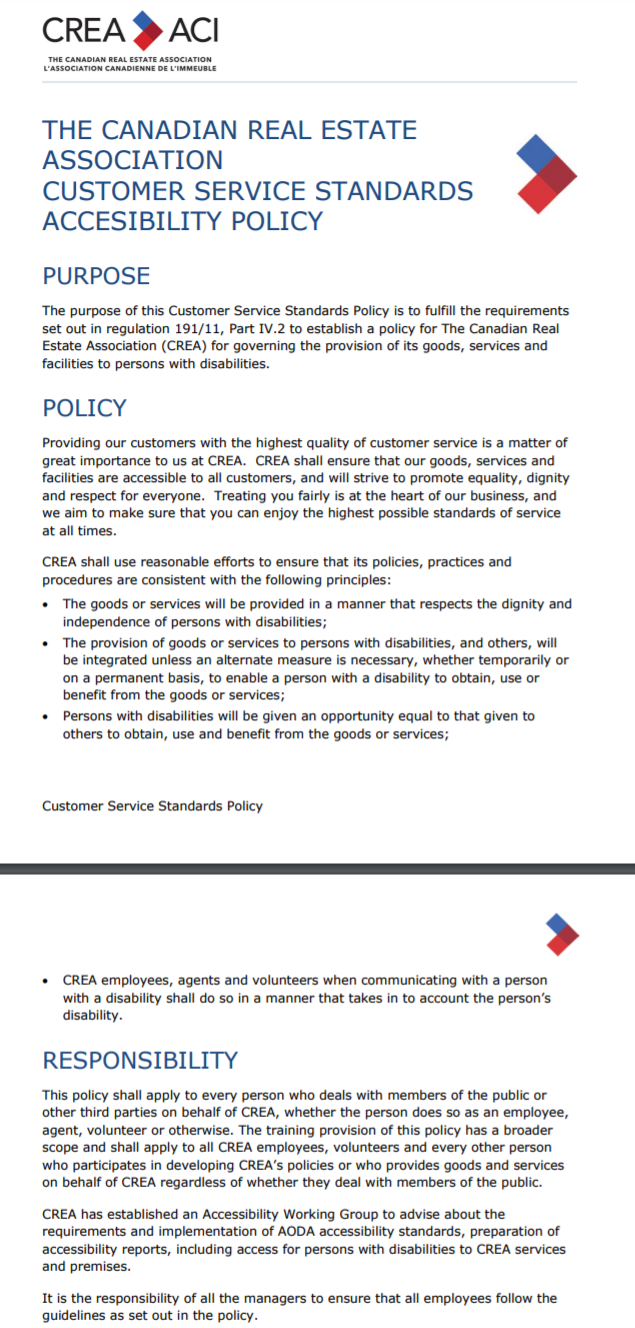
(Source)
Customer service policies also provide a broad overview of what services are (and are not) provided to customers. Similarly, the document will set parameters and exceptions to these policies as determined by the company.
As for specifics, a CSP will often provide details regarding the customer service team’s actual procedures and workflows. For example, a customer service policy may include step-by-step details of the team’s returns & exchanges process.
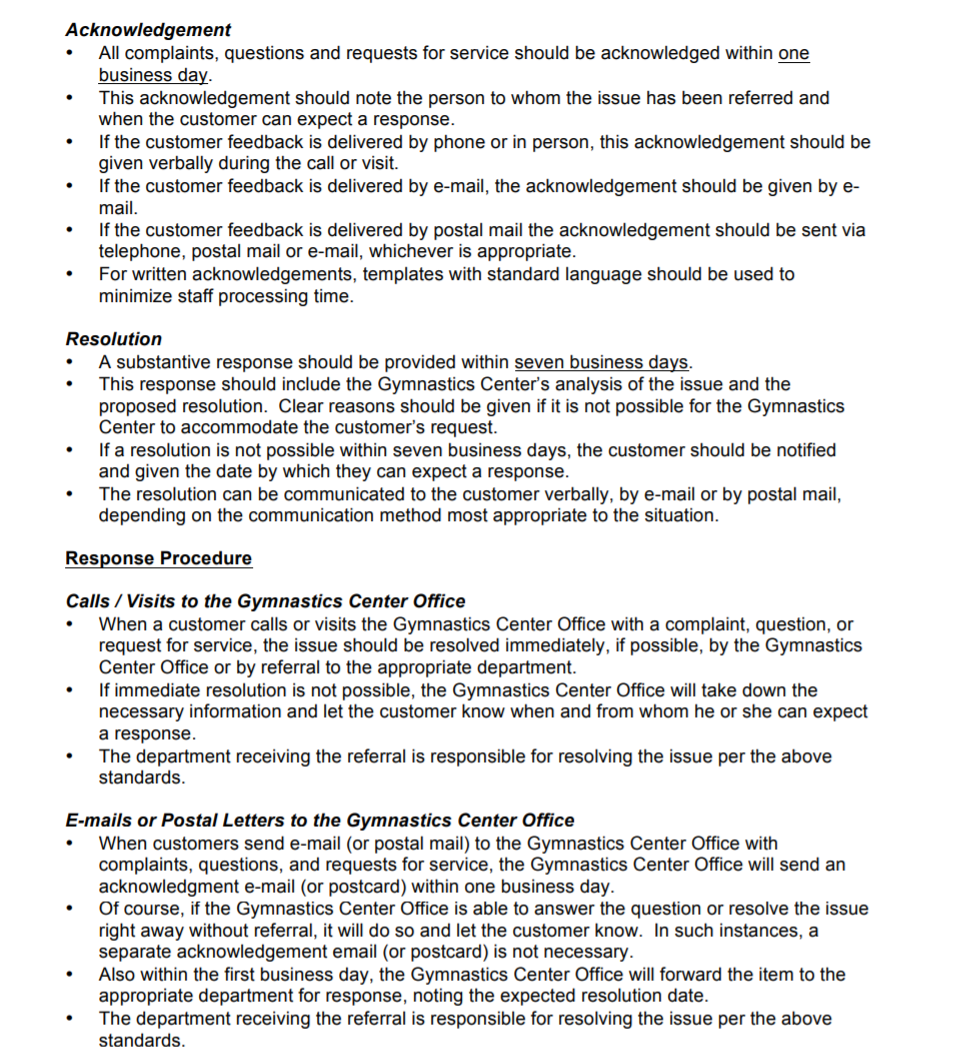
(Source)
Customer service policies are created primarily for internal use — but they can also be repurposed in order to keep the customer engaged and informed, as well. Though each “version” will differ in a number of ways, the goal of each is to showcase the brand’s intentions and strategies for delivering top-notch customer service.
Creating a Customer Service Culture: The Role of a Customer Service Policy
A customer service policy plays a vital role in creating an exceptional customer service culture. It outlines the expectations and goals for employee behavior and customer interactions, and sets the standard for the overall customer service experience. By clearly defining the expectations for customer service, a customer service policy can help to create a cohesive and consistent customer service experience across all touchpoints.
A customer service policy can also help to establish a positive and customer-focused culture within a business. By emphasizing the importance of treating customers with respect and going above and beyond to meet their needs, a customer service policy can help to create a culture that values customer satisfaction and loyalty.
Additional Benefits of Creating a Customer Service Policy
Creating a customer service policy is beneficial to your customer service team, your customers, and your business as a whole.
Customer Service Team Benefits
Developing a CSP can have both practical and holistic benefits for your customer service team.
Practically speaking, it will allow your service team to become more productive. With a clear plan of attack in hand for most (if not all) situations they typically face, they’ll always know the right steps to take to achieve the best outcome possible.
With a more consistent (and less haphazard) approach to customer service, chronic bottlenecks and other ongoing issues will also be easily identifiable. In turn, making laser-focused improvements to your on-the-ground customer service processes will be much easier moving forward.
Zooming out a bit, a well-defined customer service policy will keep your team focused on the “big picture” behind their day-to-day efforts. That is, it allows them to better understand the important role they play in helping the customer achieve their major goals — and helping the company achieve theirs.
Simply put:
A customer service policy clearly outlines the expectations of your customer service team as well as provides them with guidance on how to optimally handle different situations.
Customer-Facing Benefits
The existence of both internal and customer-facing CSPs will have a positive impact on your audience in a number of ways.
For one, a more productive customer service team (brought on by a documented CSP) means shorter wait times, along with more and faster first-touch resolutions. This alone will go a long way toward improving customer satisfaction and loyalty.
In a more direct sense, your customer service policy will help orient your customers whenever they’re in need of assistance in the first place. By setting their expectations and providing clear instruction from the get-go, you’ll enable your audience to take confident and productive steps toward accomplishing whatever task may be at hand.
(It also opens the door for additional opportunities to automate customer service — a crucial element of modern customer service in its own right.)
And, since you’ll have already set your customers’ expectations, you’ll be in a prime position to exceed them at every single touchpoint. It’s not about “underpromising and overdelivering”, but more about intentionally injecting additional value into your customer service engagements whenever possible.
Business Benefits
With a comprehensive CSP in place...
- You’ll have a more productive (and cost-effective) customer service team.
- You’ll see an increase in customer satisfaction and customer loyalty as you'll be able to consistently meet the needs and expectations of your customers.
If your customer service policy enables all of the above to fall into place, your overall business is sure to reap the benefits. Decreased customer service spending, increased retention and customer value, and improved brand reputation...it all adds up to a major shot in the arm for your bottom line.
And it all starts with a well-documented customer service policy.
Challenges of Creating a Customer Service Policy
Providing excellent customer service in itself is no easy task.
So, it isn’t all that surprising to know that creating a comprehensive customer service policy comes with its fair share of challenges. In understanding what these challenges are, though, you’ll be better equipped to meet them head on.
Getting Buy-In From Your Team
To one degree or another, resistance to change will happen with any new initiative you introduce to your organization.
But, when consistency is the name of the game, you absolutely need to know your entire customer service team is onboard with the new policy. A disjointed team will deliver an equally disjointed experience to the customer — which defeats the purpose of creating a new policy in the first place.
So, before you introduce the idea of a new policy, you’ll first need to prepare your customer service team for the potentially big changes to come. And, as the transition gets underway, you’ll need to continually reinforce your team’s efforts to ensure they don’t backslide into “the old way of doing things”.
Balancing Consistency and Autonomy
One thing we should mention is that it’s important not to mistake a consistent experience for a robotic one.
In other words, the goal of creating a CSP isn’t to force your customer service team into regimented, mechanical workflows in which they approach their customers like robots. Rather, it’s to provide a consistent level and quality of customer service, while also injecting a bit of personality and personableness to the experience.
Your CSP doesn’t have to get down to the micromanage-y details. Really, it shouldn’t.
The challenge, then, is to strike a balance between ensuring your employees always follow best practices as defined, and ensuring they’re able to approach each customer engagement with autonomy and humanity.
Knowing Your Limits
Putting the customer first is at the heart of every customer service policy.
(It’s right there in the name!)
Unfortunately, there’s only so much you can do for your customers without breaking the bank. And, there are limits to how much you should be responsible for doing when it comes to serving your customers, as well.
The fact is, there’s a fine line between “delivering high-quality customer service” and “getting taken advantage of”. The struggle, then, is in figuring out how to meet (and, when possible, exceed) your customers’ expectations at every touchpoint — while also making clear that there are limits to your generous, customer-centric policies.
(And, as we’ll get to, there’s the added challenge of staying competitive in terms of customer service while not giving too much of your team.)
What’s Included in a Customer Service Policy?
To be sure, there’s no “official” way to put together a customer service policy.
It all depends on a variety of factors, such as:
- The industry in which the company operates
- The company’s vision for their customer service initiatives
- Whether the document is for internal or customer-facing use
...and much more.
That said, your CSP will need to include the following for it to have the desired effects we’d discussed above.
1. Customer Service Mission Statement
A strong mission statement sets the stage for the purpose of your CSP documentation — and of your customer service efforts, overall.
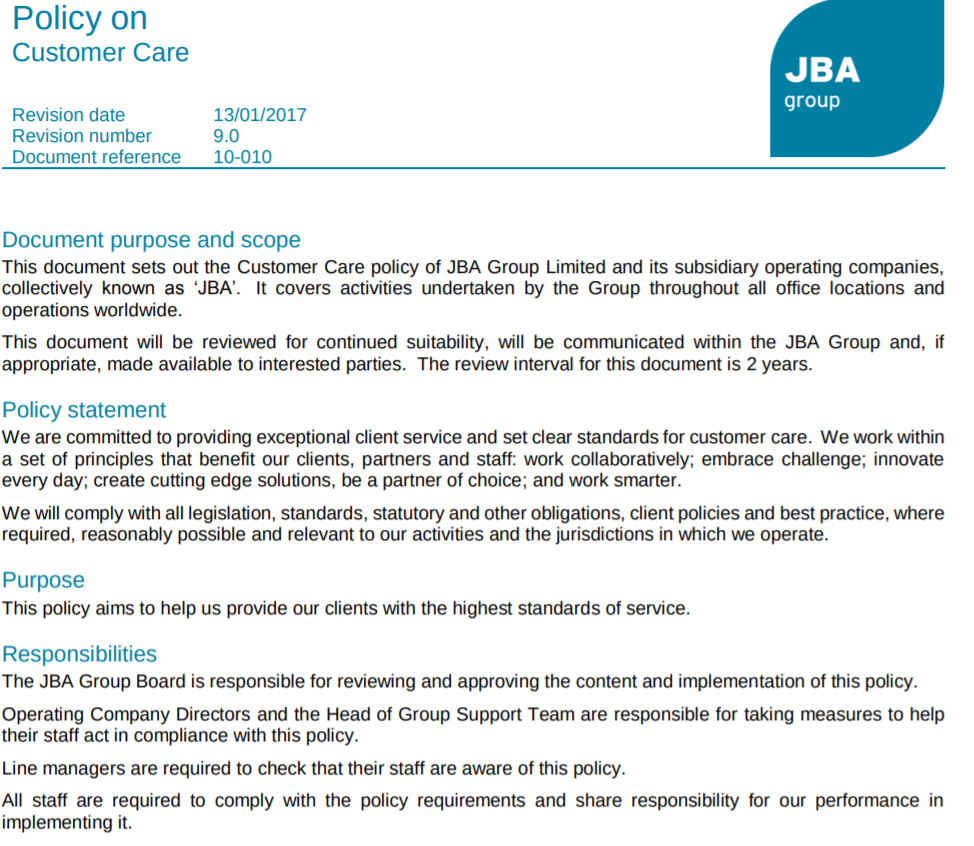
(Source)
Here, you’ll make your dedication to your customers’ satisfaction and success crystal clear. You may include language regarding any guarantees you offer your customers, as well as information as to what high-quality customer services “means” to your team.
Going a step further, you can also tie your customer service mission statement into your overall vision and mission statement for your company. Basically, you’ll want to communicate how your strategic and cohesive approach to customer service brings both your customers and company ever-closer to your respective goals.
2. Customer Service Employee and Team Standards
Your customer service policy should also include clear language setting the standard your employees and team as a whole will be expected to live up to.
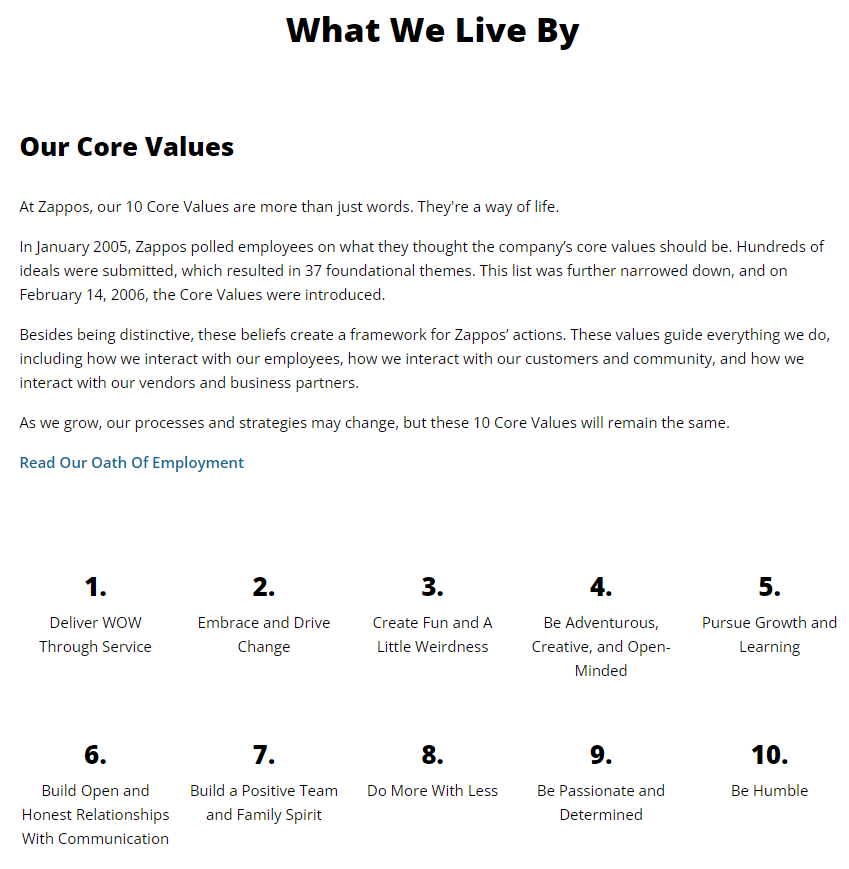
(Zappos framework makes it easy for employees to understand expectations in how to deal with customers)
Essentially, you’ll be translating the information from the previous section into more practical terms.
Some topics to address here include:
- What “customer service”, “customer satisfaction”, and “customer success” means to your team
- The responsibilities of individual employees, and those shared by your customer service team (and the overall organization)
- Standards of professionalism when engaging with customers and/or other stakeholders
Note that this information merely describes the bare minimum standards your customer service team will be expected to live up to. Ideally, your dedicated staff will continually seek out more ways to raise the bar on a regular basis.
3. Company Customer Service Policies
In this section, you’ll provide more practical information regarding your organization’s actual customer service policies.
For starters, you’ll want to discuss your team’s policies with regard to things like:

- Returns & exchanges: Do you accept returns and exchanges? Are there exceptions? What limitations are in place?
- Order fulfillment: How long do orders typically take to ship? Can customers make changes to an order once it’s placed? Can they cancel an order?
- Payment methods and options: What payment options are accepted? Do you offer financing?
This section should also provide info regarding your customer service team’s operations, such as:
- The channels on which they operate
- Their hours of operation and availability
- Their modes of response (and typical response times for each)
In reading this section of your CSP, your team and/or your customers should know a) what the customer is privy to in terms of customer service, and b) how your team will provide it to them.
4. Customer Service Procedures, Protocols, and Workflows
Taking cues from the previous section, here’s where you’ll describe the actual processes your team and/or your customers will go through when specific services are rendered.
Your internal CSP documentation should be a bit more detailed, here. Though not as in-depth as comprehensive standard operating procedure documentation, this section of your CSP should explain things such as:
Step-by-step instructions for customer intake, assessment, provision of service, and follow-up
- Decision-making policies and protocol
- Instructions for compliant use of technology and customer data
Your customer-facing documentation will explain how all this looks from the consumer’s perspective. That is, it should explain the backend processes the customer doesn’t see in a way that makes sense to them, eases any potential frustration, and strengthens their trust in the provider.
5. Escalation Policies and Procedures
(Note: This can be a section of its own, or it can be included as a subsection of the above.)
Your internal CSP document should include your team’s policies for customer service escalation — and any instructions your team should follow when such situations arise.
This info should help your customer service team:
- Identify critical moments/thresholds for escalation
- Streamline the process for the team and the customer
- Ensure each customer gets the escalated service they deserve
You might also include language defining the limits of your escalation policies. This will protect your employees from overextending themselves (and your company’s resources) in trying to fix a problem that may well be out of their hands.
6. Quality Assurances and Service Guarantees
Finally, your customer service policy should include a section on any guarantees you offer your customers — whether with regard to the services you provide, or your overall brand experience.
Some examples of what to include here:
- Information on satisfaction guarantees or money-back guarantees
- Accessibility information for individuals with disabilities, in different jurisdictions, etc.
- Assurance of fair, ethical, and equitable business operations (from data usage, to labor and materials, and more)
Though more for the customer than employee use, you might still include this info within your internal CSP to reiterate and reinforce your customer service vision in the eyes of your team.
Again, this isn’t an “official” list of what to include in a customer service policy — because there’s no such thing.
Rather, your customer service policy is just that: yours. While it should include much of the info discussed above, you’ll likely need to include additional industry- and brand-specific information within your unique CSP.
That said, you should now have a pretty good head start in determining what to include, and where to focus your attention, when creating your own customer service policy.
8 Steps to Having an Effective Customer Service Policy
With all the information a customer service policy includes, you don’t want to take a haphazard approach to creating one for your team.
(As we said at the start, great customer service doesn’t just happen by accident — and a cohesive CSP won’t come together that way, either.)
So, let’s now dig into the key steps to take when creating a customer service policy for both internal and customer-facing purposes.
1. Align Customer Service Vision With Your Company’s Vision
By now, we know to see customer service not as a “necessary evil”, but as yet another opportunity to help our customers succeed — and help bring our organization closer to achieving its goals.
It’s crucial that this is reflected throughout your customer service policy.
Your first step will be to define the value that your customer service efforts bring to your customers’ overall experiences with your brand.
This means knowing:
- How your customer service efforts aim to meet and exceed your customers’ expectations
- How excellent customer service translates to customer satisfaction and success
- How providing excellent customer service can lead to further opportunities to engage with and deliver value to your audience
Again:
Customer service isn’t something “extra” that you provide on top of your “normal” brand experiences. Rather, it’s a part of every experience your customers have with your brand — even when it’s not actively recognized.
Keep this in mind from the get-go to ensure the CSP you develop has the powerful impact you’d intended.
2. Identify Industry Standards and Customer Expectations
If you’re just starting to take a more serious and strategic approach to customer service, you’ll need a solid frame of reference to guide your efforts.
Here, you’ll be doing a little competitive analysis — focusing specifically, of course, on your competitors’ customer service efforts and policies.
First, check out your competitors’ websites, social media channels, and other public platforms. See if you can dig up information such as:
- How their customers can request customer service
- What channels they provide customer service on
- Their hours of operation and typical average handle times
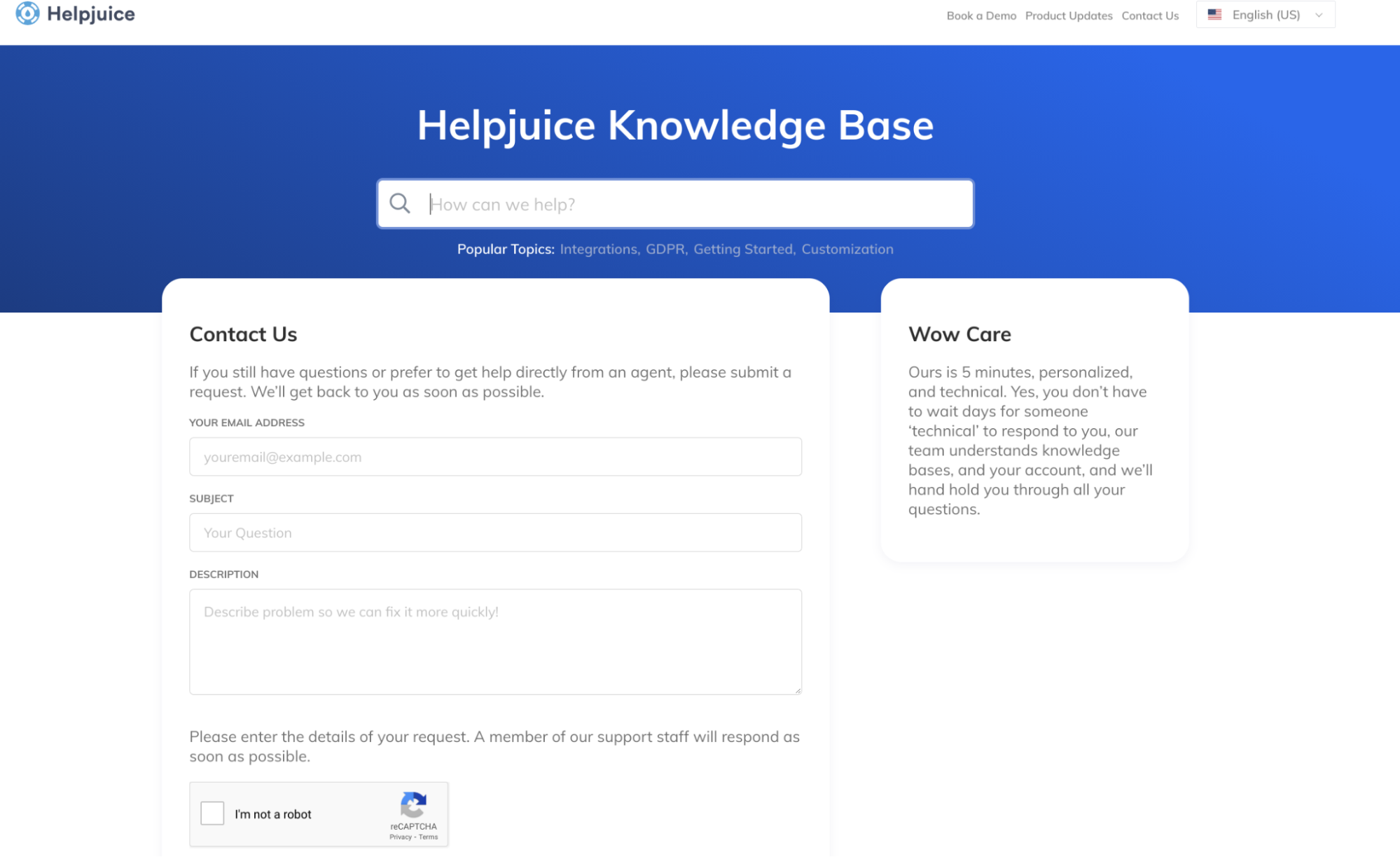
(Also, check to see what they offer in terms of self-service, as your efforts in this area can give you a huge competitive advantage.)
Similarly, look at how your competitors position their customer service initiatives. Do they…
- See customer service as separate from their normal services?
- Pride themselves on their excellent customer service?
- Integrate customer service into their brand’s image and selling point?
While your goal is to get to this “integration” stage regardless, knowing where your competitors stand will allow you to one-up them at every turn.
One last thing to start thinking of at this stage is your industry’s average performance when it comes to customer service.
Some metrics to consider here include:
- Average response time
- Average resolution time
- Customer satisfaction metrics like CSAT, CES, and NPS
Similarly, look at what your target audience is saying about your industry in terms of customer service. Customer reviews, social media comments, and other such user-generated content can all help you gain a better understanding of the customer service landscape in your industry.
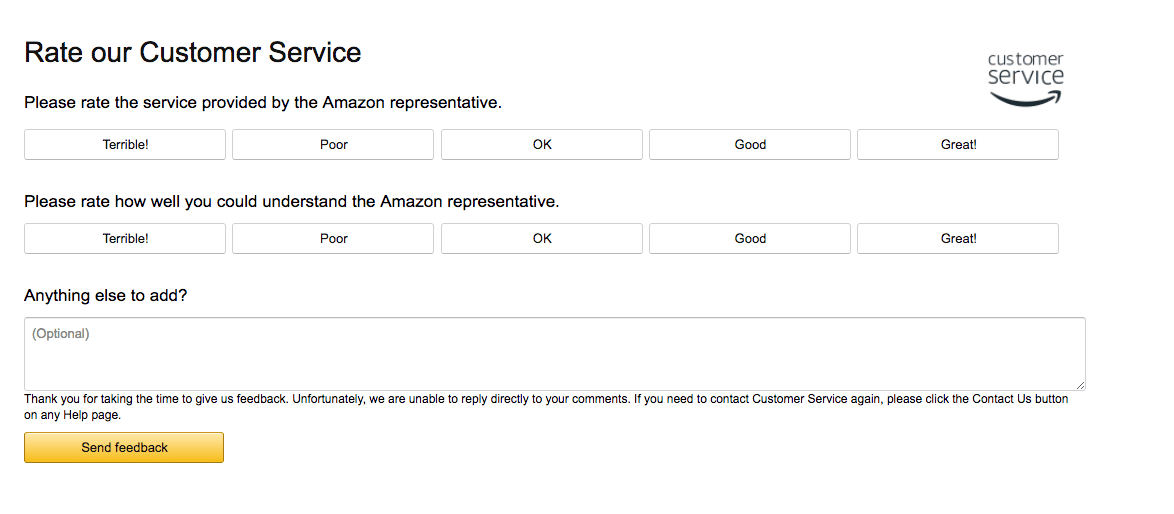
Keep all this in mind, as you’ll be referring back to it throughout the next few steps of the process...
Audit Your Current Customer Service Efforts
Your next step will be to analyze your customer service team’s efforts up to this point.
Basically, you’ll be comparing where you currently are with:
- Where your competitors are
- Where your customers expect you to be
- What you’re aiming to build your customer service initiatives up to be
First, take a look inward. Your customer service team’s performance data, coupled with in-depth feedback from your team members, will show you what’s going well, what areas may need improvement — and what, specifically, you can do to make said improvements.
When engaging with your frontline service reps, you’ll want to dig into topics such as:
- How you can better enable them to serve the customer
- How processes and workflows can be improved to optimize performance
- How customers are responding to your current efforts — and what else they may be looking for
You can then start looking outward — that is, to your customers — to flesh out the information you’ve collected thus far.
Some info to uncover here:
- Your audience’s level of satisfaction with your customer service efforts
- What your customers believe is missing from your customer service initiatives
- How your audience believes customer services fits into your overall brand experience
Combined with the information collected in the previous step, you’ll almost have everything you need to put together a comprehensive and cohesive customer service policy.
Set Goals and Benchmarks for Future Customer Service Efforts
The final stage before actually writing your CSP is to set specific goals for your customer service initiatives moving forward.
You can start by looking at your more immediate performance goals. Using the data you’ve collected from your customer service performance evaluation forms as well as your knowledge of your service team’s capabilities, set goals for your team that, though attainable, will require a dedicated effort from your employees.
Beyond response times and other surface-level metrics, set goals for the more qualitative side of your customer service efforts.
- What do you want your customers to say about your customer service?
- How do your customer service efforts impact their decision to engage with your brand?
- To what degree do they view your customer service initiatives as a part of your overall brand experience?
These (and other) questions will help you set realistic goals for the future of your customer service efforts.
From there, trace your customer service goals to your overall business goals to ensure your efforts will be worthwhile.
Some factors to consider here:
- Increase in productivity (for service, support, and other customer-facing teams)
- Resources and time saved
- Customer engagement increases (e.g., retention purchase frequency, order value, etc.)
Though your CSP won’t necessarily include these nitty-gritty goals in the text, they’ll effectively be the driving force behind the language within your policy.
Create Your Customer Service Policy Documentation
Alright, now you’re finally prepared to write your customer service policy.
We’ve already discussed this part at length, but let’s quickly reinforce some best practices here.
Above all else, keep it simple. Your customer service policy — even the internal version — should be as short and to the point as possible. While you do want to communicate the intended information with clarity, this isn’t the time to dive deep.
(That said, you can provide resources for further reading throughout or as an addendum to your CSP for interested readers.)
Secondly: Write practically, with your intended audience in mind.
Your internal CSP should serve to orient, instruct, and motivate your customer service team to provide the best service they can to the consumer. Your customer-facing CSP should alleviate your audience’s worries and hesitations — and increase the trust they place in your team to help them succeed.
Lastly: Include your customer service team in the writing process. While team leads and other stakeholders will be involved, as well, your customer service team should take ownership of the policy and its documentation to ensure they truly internalize it.
Make Your Customer Service Policy Easily Accessibly
Writing your customer service policy is only half the battle when it comes to the actual documentation process.
The other essential aspect to the documentation process is to ensure that your customer service policy can easily be found, shared, and edited by the appropriate staff members.
This is where making use of the best knowledge base software is essential.
By creating a knowledge base, your customer service managers can easily create and share policies that customer service team members can check when needed. This allows your CS team to quickly find accurate information when they need it which ensures they provide the best possible customer service to your end users.
Moreover, with a knowledge base, you can set user permissions, allowing you to create customer service policies that are only accessible by employees as well as ones that are public-facing for customers.
Train Your Employees and Begin the Transition
Even if your customer service is onboard with the changes made within your policy, they’ll need some time to get acclimated to the new way of doing things.
In many cases, they may need more intentional training and development. This is especially true when implementing new workflows, or adding new technology to existing workflows.
Providing open access to organizational knowledge will give your service team clear direction as they undertake these new initiatives.
And offering continual reinforcement via regular check-ins and meetings will keep your customer service team focused on your company’s True North.
Assess and Improve Your Customer Service Efforts Over Time
If you’ve taken a more dedicated and strategic approach to creating your CSP, you shouldn’t have to make too many changes to it over time.
After all, your customer service policy is the foundation on which you build your more nitty-gritty customer service efforts. Though you will need to tweak your tactics as time goes on, your overall strategy and approach should remain pretty sound.
That said, it’s important to make sure that any changes to your day-to-day customer service operations still reflect the “big picture” vision you have for your team. While it’s one thing to stay agile to better serve the customer, you don’t want to be so flexible that you disregard your team’s policy.
(And, once more, you definitely don’t want to allow your customer service team to get taken advantage of.)
Whenever you do make changes to your customer service policy, you need to be sure that all involved stakeholders are aware of said changes, and that they’ve made the appropriate adjustments to their processes.
Looking to keep your customer service policy and other documents as organized and accessible as possible? Check out Helpjuice’s knowledge base software today.
Customer Service Policy Examples
Here are some examples of successful customer service policies from different industries.
1. Zappos
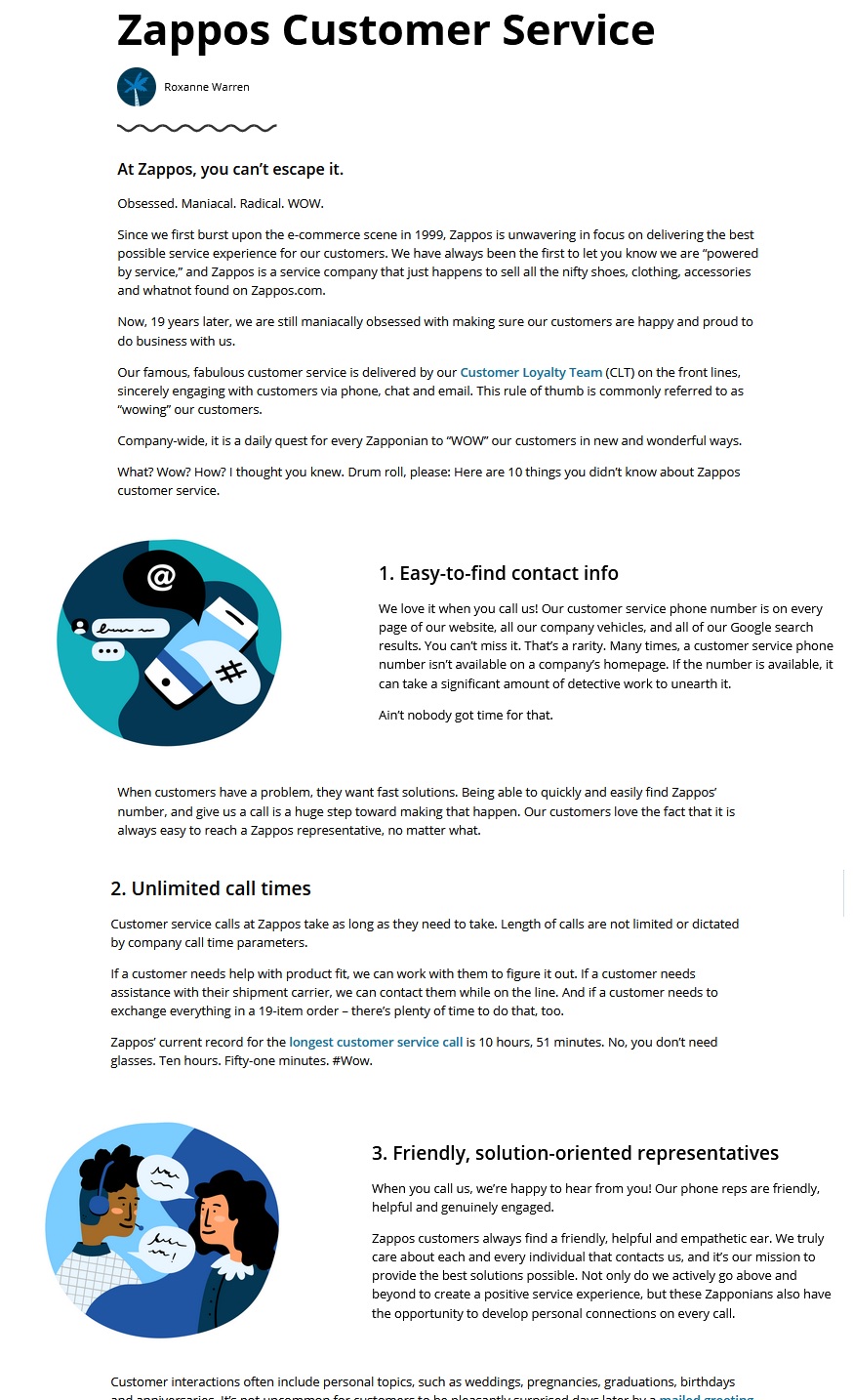
Much of the success that Zappos has been able to achieve is due to its exceptional customer service, and its customer service policy reflects this. It includes elements such as a commitment to providing fast and helpful responses to customer inquiries, a 100% satisfaction guarantee, and a focus on building long-term relationships with customers.
2. Disney
The Disney company is known for its "Disney Way" customer service policy, which emphasizes the importance of creating a positive and magical experience for guests. It includes elements such as being friendly and helpful, going above and beyond to meet customer needs, and maintaining a clean and orderly environment.
3. Ritz-Carlton
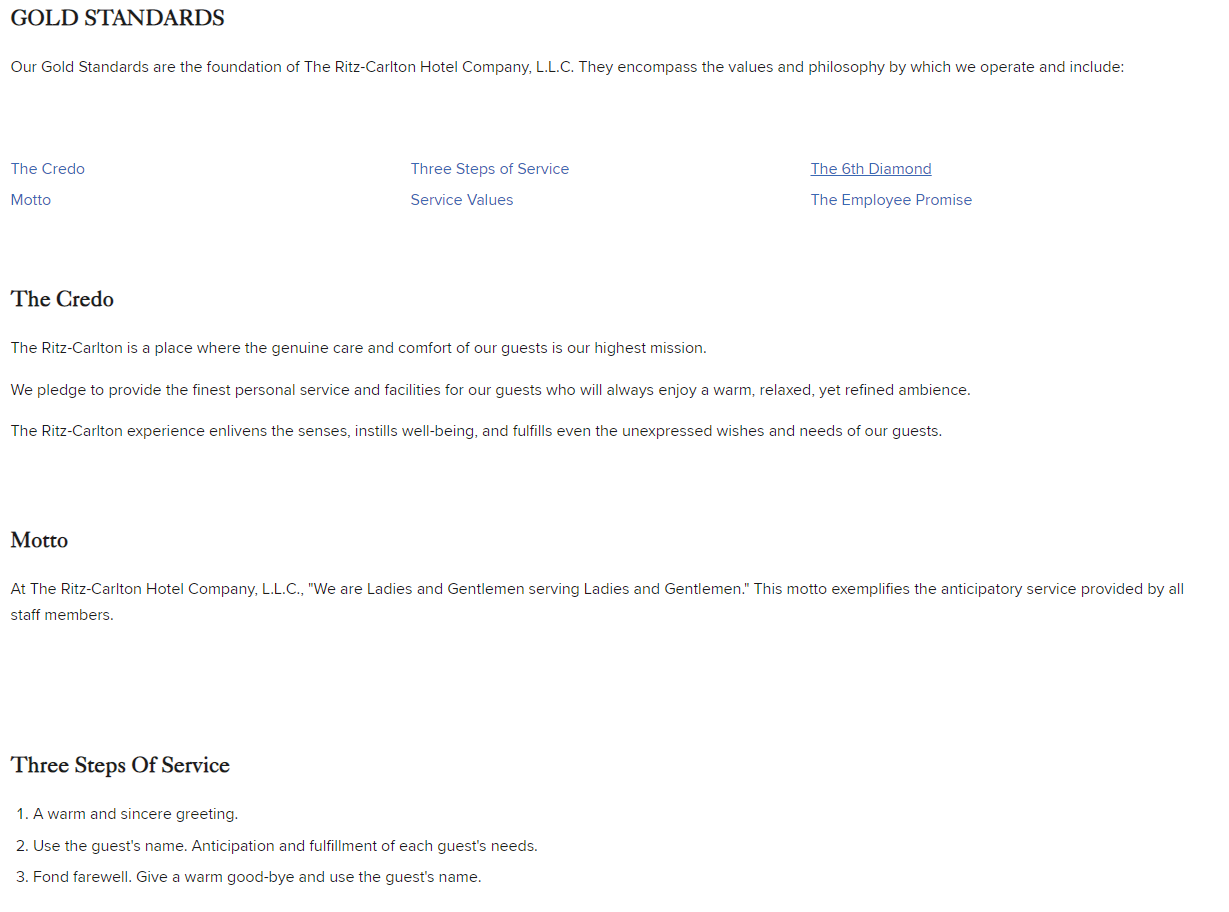
This luxury hotel chain has a customer service policy called the "Gold Standards," which includes elements such as providing personalized service, anticipating and exceeding customer needs, and ensuring that every interaction with a customer is a memorable one.
4. Nordstrom
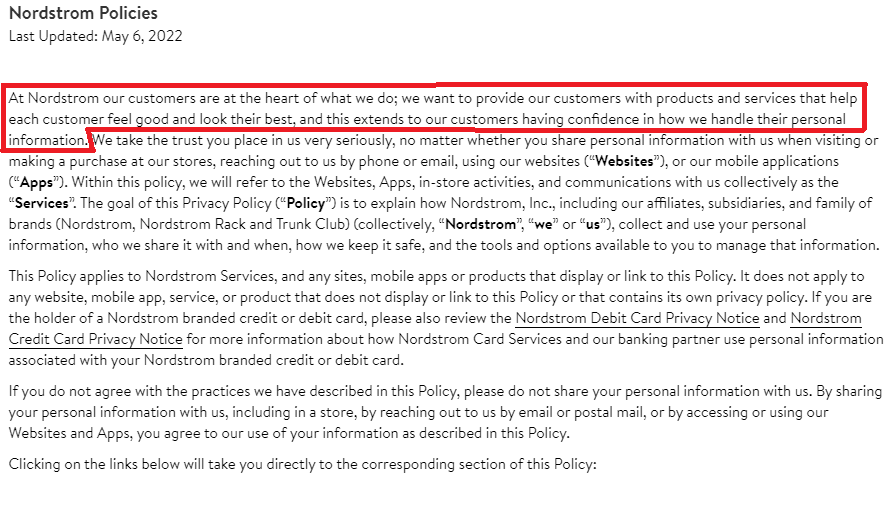
Nordstrom's brand is synonymous with exceptional customer service. Their customer service policy shows why as the company stats that customers are at the heart of what they do.
Customer Service Policy Template
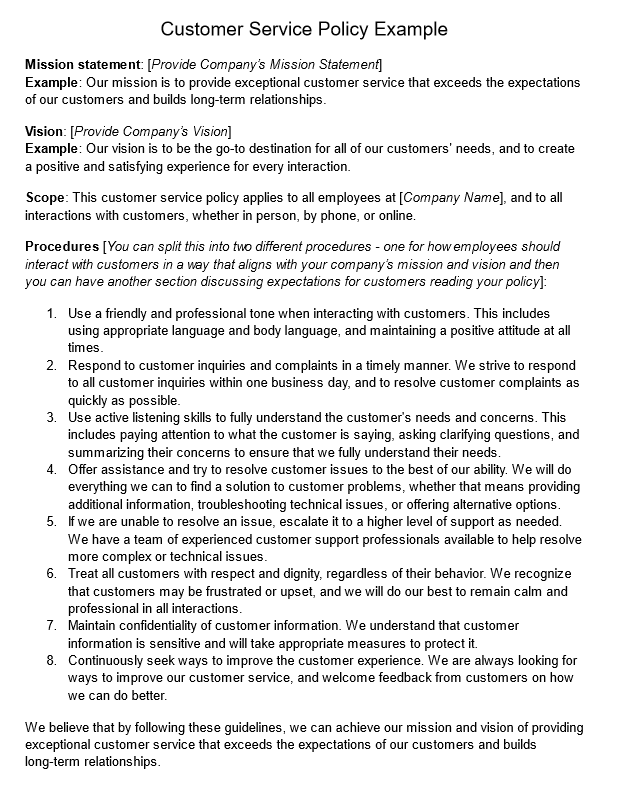
You can download the above template for Word or use it in Google Docs as a starting point for creating your own customer service policy. Just remember the following key points when crafting a customer service policy that's unique to your company:
- Introduction: Begin by introducing the purpose of the customer service policy and outlining its key objectives.
- Customer service goals: Clearly state the goals of your customer service efforts, such as providing fast and helpful responses to customer inquiries and complaints, or creating a positive and memorable experience for customers.
- Customer service expectations: Outline the specific expectations for employee behavior and customer interactions, such as using a friendly and professional tone, actively listening to customer needs and concerns, and maintaining confidentiality of customer information.
- Procedures: Detail any specific procedures that should be followed in different situations, such as how to handle customer complaints or how to escalate issues to higher levels of support.
- Communication: Describe how the customer service policy will be communicated to employees and customers, and how it will be consistently followed and monitored.
- Review and update: Outline a process for regularly reviewing and updating the customer service policy to ensure that it stays relevant and effective.
Supporting Your Customer Service Policy With a Knowledge Base
A knowledge base can be a useful tool for supporting a customer service policy in several ways:
- Providing information and resources: A knowledge base can be a source of information and resources for customers, such as FAQs, how-to guides, and product documentation. This can help customers find the answers they need quickly and independently, which can improve the overall customer experience.
- Standardizing responses: A knowledge base can be used to standardize responses to common customer inquiries and issues. This can help ensure that customers receive consistent and accurate information, and can reduce the workload for customer service staff by providing them with pre-written responses to refer to.
- Improving efficiency: By providing customers with the resources they need to find answers and resolve issues on their own, a knowledge base can help improve the efficiency of the customer service process. This can free up customer service staff to focus on more complex or specialized issues that require more attention.
- Enhancing transparency: A knowledge base can be used to make information about your products, services, and policies more transparent and accessible to customers. This can help build trust and enhance the overall customer experience.
Wrapping Up: The Power of a Customer Service Policy
Customer service policies play a vital role in ensuring that businesses provide a positive and satisfying experience for their customers. A well-crafted customer service policy should outline the goals and expectations for employee behavior and customer interactions, as well as any specific procedures that should be followed in different situations.
It's important to involve relevant stakeholders in the process of creating and implementing a customer service policy to ensure that it meets the needs of all parties. Regular reviews and updates are also essential to ensure that the customer service policy stays relevant and effective over time.
By following best practices and tailoring a customer service policy to the specific needs of your business and its customers, you can create a customer service experience that fosters long-term customer loyalty and satisfaction.
Looking to keep your customer service policy and other documents as organized and accessible as possible? Check out Helpjuice’s knowledge base software today with a free 14-day trial.

![What is a Customer Self-Service Portal [And How to Create One]](https://static.helpjuice.com/helpjuice_production/uploads/upload/image/4752/direct/1639682572268-Customer%20Self%20Service%20Portal.jpeg)


